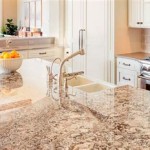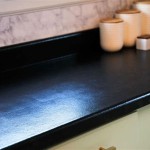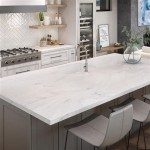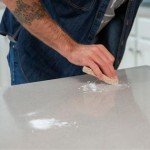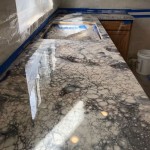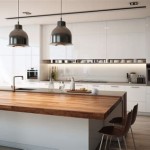Wood Countertop for Washer and Dryer: A Practical and Aesthetic Upgrade
Integrating a wood countertop above a washer and dryer unit presents a compelling combination of practicality and aesthetic appeal for laundry rooms. This design choice transcends mere functionality, transforming a utilitarian space into an organized and visually pleasing area. The selection, installation, and maintenance of a wood countertop for a washer and dryer require careful consideration to ensure durability, stability, and long-term satisfaction.
The primary function of such a countertop is to provide a stable and expansive surface for folding laundry, sorting clothes, and storing laundry essentials. A well-chosen wood countertop can effectively dampen vibrations from the machines and minimize noise transmission, enhancing the overall laundry experience. Moreover, it offers an opportunity to conceal unsightly appliances and create a unified aesthetic throughout the room. The material's warmth and natural beauty contrast favorably with the often sterile appearance of laundry appliances, elevating the room's design.
Material Selection: Choosing the Right Wood Species
The choice of wood species is a critical factor in determining the countertop's longevity and aesthetic properties. Hardwoods like maple, oak, walnut, and cherry are popular choices due to their durability and resistance to wear and tear. Each species offers a unique grain pattern and color variation, allowing homeowners to select a wood that complements their existing décor. Softer wood species, such as pine, can also be used, but they require a more robust sealant and are more susceptible to dents and scratches. The selected wood must also be properly kiln-dried to minimize warping and cracking over time. Cost considerations often factor into the decision-making process, with certain hardwoods being more expensive than others. The wood's inherent water resistance should also be considered, particularly in a laundry room environment where spills and humidity are common occurrences.
Butcher block countertops, constructed from multiple wood pieces glued together, are also a viable option. This construction method enhances the wood's structural integrity and creates a visually appealing pattern. Butcher block can be made from various wood species, allowing for customization to match the desired aesthetic. The thickness of the butcher block is another important consideration, as thicker countertops generally provide greater stability and durability. The adhesive used in the construction of butcher block countertops should be waterproof and food-safe to ensure the countertop's longevity and safety.
Beyond solid wood, engineered wood products like plywood and MDF (Medium-Density Fiberboard) can be used as a substrate for wood veneers or laminate surfaces. While these options are generally more affordable, they may not offer the same level of durability and aesthetic appeal as solid wood. If using engineered wood, it is crucial to ensure that it is properly sealed to prevent moisture damage and warping.
The sustainability of the wood source is an increasingly important consideration for environmentally conscious homeowners. Choosing wood that is certified by organizations like the Forest Stewardship Council (FSC) ensures that the wood is harvested from responsibly managed forests. This practice helps to protect biodiversity and maintain forest ecosystems for future generations.
Installation Considerations: Ensuring Stability and Safety
Proper installation is paramount to ensure the countertop's stability and prevent potential safety hazards. The countertop must be securely attached to the washer and dryer units or the surrounding cabinetry. This typically involves the use of heavy-duty brackets or supports that are capable of withstanding the weight of the countertop and any items placed on it. The supports should be strategically positioned to distribute the weight evenly and prevent sagging.
Accurate measurements are essential to ensure a precise fit. The countertop should be slightly larger than the combined width and depth of the washer and dryer units, allowing for adequate clearance around the machines. This clearance facilitates maintenance and prevents the machines from coming into direct contact with the countertop, which could cause damage or vibrations. A template can be created to guide the cutting and shaping of the countertop, ensuring a professional and accurate result.
When installing the countertop, it is crucial to consider the potential for vibrations from the washer and dryer. Vibration-dampening pads or shims can be placed between the countertop and the machines to minimize noise and prevent the countertop from shifting. The countertop should also be level to prevent items from sliding off. A spirit level can be used to ensure that the countertop is perfectly horizontal. The installation process may require professional assistance, particularly for homeowners who lack experience with woodworking or construction.
Adequate ventilation is also important to prevent moisture buildup and mold growth. The countertop should be designed to allow for airflow around the washer and dryer units. This can be achieved by leaving a small gap between the countertop and the wall or by incorporating ventilation grilles into the design. Proper ventilation helps to maintain a dry and healthy environment in the laundry room.
Safety precautions should be taken during the installation process to prevent injuries. Eye protection, gloves, and a dust mask should be worn to protect against wood splinters and dust. Power tools should be used with caution and in accordance with the manufacturer's instructions. The work area should be well-lit and free of clutter to prevent accidents.
Maintenance and Care: Prolonging the Countertop's Lifespan
Regular maintenance is necessary to preserve the appearance and integrity of the wood countertop. This includes cleaning up spills promptly to prevent staining and water damage. A mild soap and water solution can be used to clean the countertop, followed by a thorough drying with a soft cloth. Harsh chemicals and abrasive cleaners should be avoided, as they can damage the wood's surface. The countertop should be inspected regularly for signs of damage, such as scratches, dents, or water stains.
Applying a sealant or finish is crucial to protect the wood from moisture and wear. A polyurethane finish provides a durable and water-resistant barrier, while an oil-based finish enhances the wood's natural beauty and provides a softer touch. The choice of finish depends on the desired aesthetic and the level of protection required. The finish should be applied according to the manufacturer's instructions, and multiple coats may be necessary to achieve optimal protection.
Periodic re-sealing or re-finishing may be required to maintain the countertop's luster and protect it from damage. The frequency of re-sealing depends on the type of finish used and the level of use the countertop receives. Signs that the countertop needs to be re-sealed include dullness, water stains, and peeling finish. The re-sealing process typically involves sanding the countertop to remove the old finish, cleaning the surface, and applying a fresh coat of sealant.
To prevent scratches and dents, cutting boards should be used when preparing laundry detergents or other cleaning products on the countertop. Hot items should be placed on trivets to prevent heat damage. Heavy items should be distributed evenly across the countertop to prevent sagging. The countertop should be protected from direct sunlight to prevent fading and warping. Window coverings can be used to block out sunlight during peak hours.
Addressing minor damage promptly can prevent it from escalating into more serious problems. Small scratches and dents can often be repaired with wood filler or touch-up paint. Water stains can sometimes be removed with a specialized wood stain remover. More serious damage may require professional repair. Consulting with a professional woodworker or furniture restorer can help to determine the best course of action for repairing damaged wood countertops.

Wooden Washer And Dryer Top Laundry Organization Room Countertop Wood Table Furniture Etsy

Diy Waterfall Butcher Block Washer Dryer Counter We The Dreamers

Diy Wood Laundry Room Countertop Love Renovations

Diy Butcher Block Counter Top A Step By Tutorial

Diy Wood Laundry Room Countertop Love Renovations

Tileon Kitchen Countertop Wood For Diy Washer Dryer Counter Top Table Office Desk And White Yqhdra806 The Home

Washer And Dryer Topper Laundry Room Organization Country Wood Farmhouse Table Top Gift Etsy

Diy Laundry Room Countertop Shelf And Easy Youtube

Diy Laundry Room Table Breezing Through

Black Washer And Dryer With Light Wood Countertop

